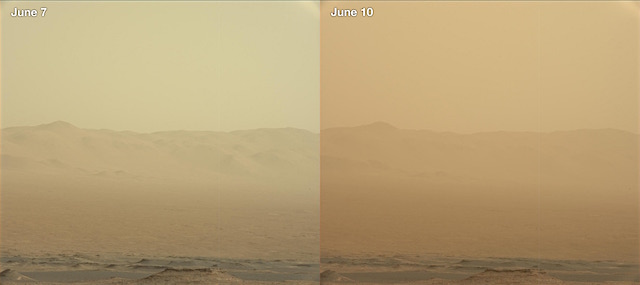 One of the thickest dust storms ever observed on Mars has been spreading for the past week and a half. The storm has caused NASA’s Opportunity rover to suspend science operations, but also offers a window for four other spacecraft to learn from the swirling dust.
One of the thickest dust storms ever observed on Mars has been spreading for the past week and a half. The storm has caused NASA’s Opportunity rover to suspend science operations, but also offers a window for four other spacecraft to learn from the swirling dust.
NASA has three orbiters circling the Red Planet, each equipped with special cameras and other atmospheric instruments. Additionally, NASA’s Curiosity rover has begun to see an increase in dust at its location in Gale Crater.
“This is the ideal storm for Mars science,” said Jim Watzin, director of NASA’s Mars Exploration Program at the agency’s headquarters in Washington. “We have a historic number of spacecraft operating at the Red Planet. Each offers a unique look at how dust storms form and behave — knowledge that will be essential for future robotic and human missions.”
Dust storms are a frequent feature on Mars, occurring in all seasons. Occasionally, they can balloon into regional storms in a matter of days, and sometimes even expand until they envelop the planet. These massive, planet-scaled storms are estimated to happen about once every three to four Mars years (six to eight Earth years); the last one was in 2007. They can last weeks, or even months at the longest. (…)
All dust events, regardless of size, help shape the Martian surface. Studying their physics is critical to understanding the ancient and modern Martian climate, said Rich Zurek, chief scientist for the Mars Program Office at NASA’s Jet Propulsion Laboratory in Pasadena, California.
“Each observation of these large storms brings us closer to being able to model these events — and maybe, someday, being able to forecast them,” Zurek said. “That would be like forecasting El Niño events on Earth, or the severity of upcoming hurricane seasons.” [More at link]








